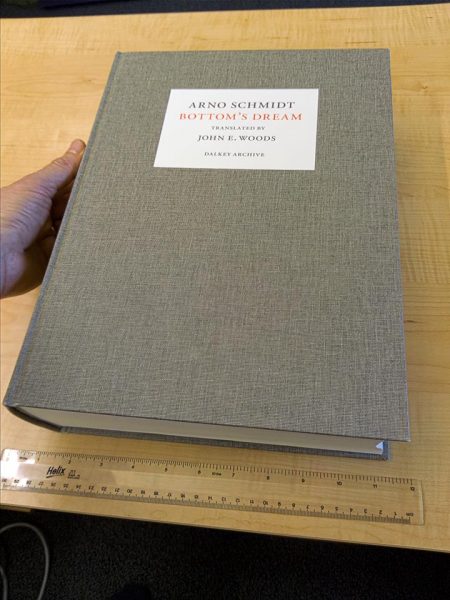
Of postwar authors whose work shows evidence of serious ambition and engagement with mid-century literary experimentation, Schmidt is perhaps the most important and least read. There are about a dozen books and PhD theses on his work in German, and about five books and essays in English. One of those, Volker Langbehn’s Arno Schmidt’s Zettel’s Traum: An Analysis (Rochester, NY: Camden House, 2003), quotes a review by Jeremy Adler of some of Schmidt’s books:
If Heinrich Böll was the conscience of the nation and Günter Grass put political engagement on the literary agenda, Schmidt was the gand experimenter. [New York Times, January 8, 1995]
This isn’t bad as a first orientation. The next thing that needs to be known is that Schmidt avoided reading Ulysses until he was in his 40’s, and that he avoided and resisted Finnegans Wake his entire life. Schmidt’s magnum opus (no less pretentious expression will do), Zettel’s Traum, translated as Bottom’s Dream, is a massive answer to Finnegans Wake. (The response begins in the title. Finnegans Wake omits the apostrophe, contrary to English-language orthography, and Zettel’s Traum inserts it, contrary to German orthography.)
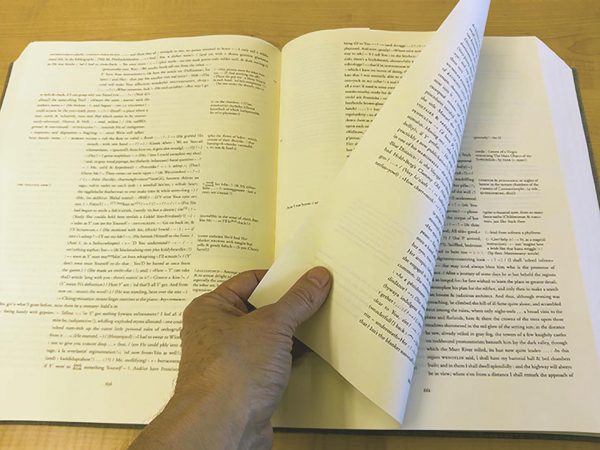
From that point things get complicated. My own interest in Schmidt has mainly to do with his typography and formatting. He worked on a typewriter (he called his oversize books “typoscripts”), made constant use of non-phonetic signs ( ” < >> … ! ?? etc.), and experimented with multiple columns and marginalia. There are some maps, photos, and other visual material as well, but he was consistently non-visual in his imagination. More on all that at the end.
There are many Schmidt resources online in German, which can be found linked to the Schmidt Stiftung. The one called GASL is the most extensive. There are at least four blogs that record partial readings of Bottom’s Dream (all the authors gave up). They’re a little tricky to find: there’s an exemplary reading of the first page (and a pdf essay); in English there’s a reading of the German text (!), up to page 350 or so; also in English another partial reading and a Goodreads group. Most of these ended in 2016-18. The German Wikipedia page for “Zettels Traum” has more links, including a useful roster of allusions in Book 1. There are, of course, many essays and several books in German; the Schmidt Stiftung is a good place to start to look for those.
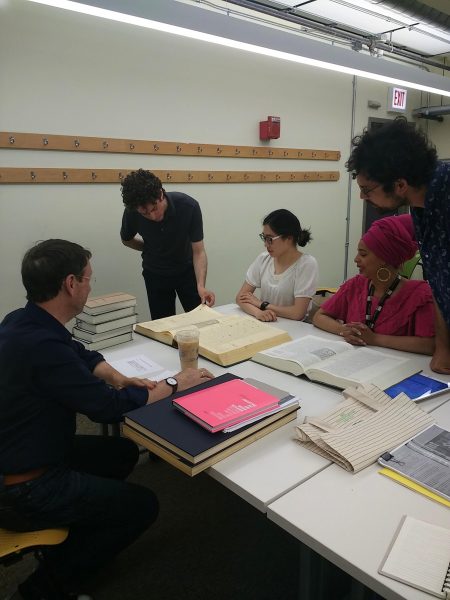
(That’s me with some of the summer 2018 Schmidt reading group.)
The reception of Schmidt has been minimally about those elements, and mainly focused on his “etym theory,” so I will begin there.
First, however, I should probably say what I’ve read: Nobodaddy’s Children and most of Evening Edged in Gold, some essays, and parts, including Book I, of Bottom’s Dream. I have German and English editions for both of the large novels. In Bottom’s Dream, I’ve read Books I and VII in detail, several times each, and sampled the others. I compare back and forth, but I read in English. So these comments should be taken for what they are: the result of a fairly, but by no means exhaustively, dedicated encounter with a much larger body of work.
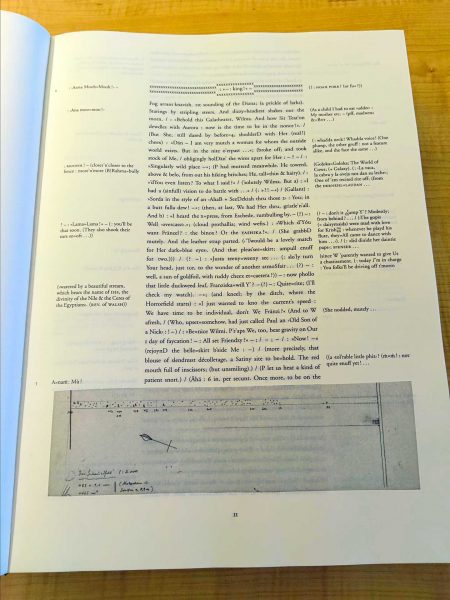
The etym theory
Zettel’s Traum is a book about a critic of Edgar Allan Poe named Dän Pagenstecher (the Umlaut is a token of Schmidt’s relentless respellings of German, English, and other languages he uses, except, interestingly, Latin, which he tends to quote verbatim), two translators whom he visits, and their daughter Fränzi. Dän is also a mouthpiece for the implied author, and in the course of Zettel’s Traum Schmidt is repeatedly very nearly Dän, and he’s also implicated in the text in ways that demote Dän. This intermittent identification is echoed by the fact that Dän is sometimes identified in third person, and other times in first person. (I don’t know any other work of fiction that slides back and forth as seamlessly as this between third and first person.)
As in the Jeremy Adler précis, things multiply from there, and there’s good sense in saying the book is also a palimpsest in which many hundreds of actual authors (whose work is presented without quotation marks) speak alongside and even inside the named characters. Bottoms Dream contains its own theories of quotations, palimpsest, and plagiarism. Schmidt even quotes Poe on the subject: “plagiarism, even distinctly proved, by no means necessarily involves any moral delinquency” (p. 1,109). At one point there is a celebration of the effects produced by not attributing texts to individuals: “a pair=wise working out of a >better reality<… is both as exclusive as it is creative–a mental nonstop=bridal-nite.” (p. 1,397). But against readings of the book that propose it’s a postmodern demonstration of distributed authorship and the unlocatable authorial intention, it needs to be said virtually all passages from Poe and others are both quoted and attributed.
In the course of the book’s 1,330 pages (1,493 in the English), Dän exposits his theories about Poe. Words absolutely fail when it comes to describing Dän’s enterprise. “Indefatigable” sounds weak, and “compulsion” or “obsession” are not much better; on the other hand it isn’t psychotic, impressionistic, or formless. It is, I think, the most extended literary interpretation in the entire history of writing. I posted this question on Facebook in August 2018: Is Zettel’s Traum the longest interpretation of a work of fiction or a writer? I got some interesting answers. It is longer than Nabokov’s comments on Eugene Onegin, but shorter than Charles Singelton’s three volumes of commentary on Dante, which run to 2,200 pages. But those are both annotations–Nabokov and Singleton comment on each verse in turn–and not continuous narratives. One person suggested the Talmud, and another suggested tafsir (for example Ibn Kathir’s), commentaries on the Quran. Either would be much longer than Schmidt’s novel, but it’s hard to know what such a comparison might mean. If we limit the comparison to continuously narrated, fictional commentaries on fiction, then there is one: Sartre’s The Family Idiot is 2,808 pages, and it is ambiguously a work of biography, a novel (as he said), and a textual commentary, even though the fourth volume, on Madame Bovary, was never finished. However, that book is 2,808 pages in octavo, and Schmidt’s pages are much larger. They are very roughly 1,300 words per page, so if a page is 300 words, that would be the equivalent of 4,200 pages. Another person on Facebook noted that there are shelves of Joyce commentary, although they’re separate books; the longest single interpretive project about Joyce that I know is the Finnegans Wake Notebooks at Buffalo project, but it’s facsimiles and notes, not continuous narrative. So I think Zettel’s Traum is the longest continuously narrated fictional account of a writer’s work.
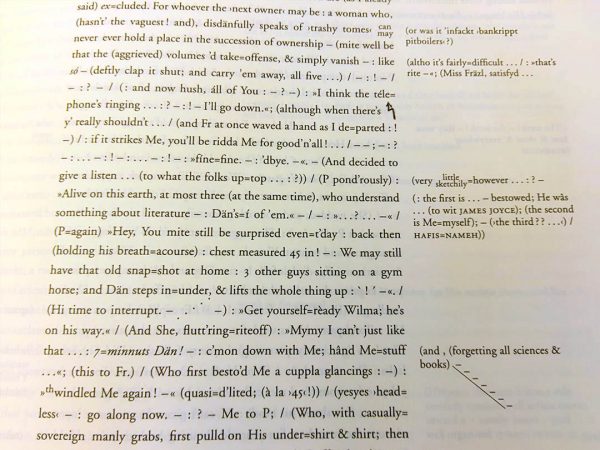
The book turns on what is called the “etym theory,” which is a way of reading inadvertent clues in an author to discover different meanings in the text. The result, on any given page, is a torrent of sexual puns, because most of Dän’s readings involve uncovering sexual meanings that have been lightly hidden by language. On average there are on the order of 10 sexual puns per page–sometimes many more–so again very roughly speaking Zettel’s Traum has twenty thousand lascivious or obscene ideas in it. The book is a torrent of naughty puns. At one point Schmidt calls it a Wortplasma, a word Woods translates as “Muddyfickation” (English 408 / German 405). These aren’t equal-opportunity puns: they are hopelessly sexist.
Parenthesis on Schmidt’s sexism
There are many examples, here and in Evening Edged in Gold, of notions about what women are like, and what they want. Just a few of them would be enough to shut down readings in seminars I teach. There are three older men in Evening Edged in Gold, each one a surrogate for the author, and they ogle, slaver, drool, project, and fantasize unremittingly. Schmidt seems to think their outrageous and horrible opinions are good because they’re honest, and therefore entertaining. He seems not to have imagined a reader for whom those ideas aren’t new, outrageous, funny, entertaining, or really anything except endlessly self-absorbed and unreflective. In that book and in Zettel’s Traum the conversations include young women (12, 15, 16 years old) who are interesting and improbably both because they are improbably well educated (like little female versions of Schmidt), and because they love being toyed with as potential sex objects. A glimpse of all this–really nothing more than that!–is a table, on p. 741 of Zettel’s Traum, comparing the sexual lives of men and women. “Male gender” begins: at age 4 1/2, “initial signs of a boyish nature,” ad concludes at age 86 1/2, mentioning the “best years of the male,” the “zenith of sexuality,” etc., along the way. The column for “Female gender” begins at age 3 1/2 and ends at 49! Apparently there’s just nothing to be said for women past that age. I found the author’s unawareness of the abysmal nature of his ideas about women intolerable in Evening Edged in Gold, and I did not finish the book’s last hundred pages. (Note: it’s not the sexist ideas per se: I’ve read any number of sexist, racist, sociopathic novels. It’s the author’s blindness to potential readers’ reactions, in contrast to his exquisite self-awareness when it comes to literature. The contrast is itself unbearable.) So far, my reading of Bottoms Dream isn’t crippled in that way, because the puns are all (supposedly) in Poe’s texts.
Returning to the topic
“Etyms” are inadvertent meanings in an author’s texts that can be revealed by an appropriately attentive and psychoanalytically-inclined reader. Schmidt was influenced by Freud–again, in complex ways, dependent mostly on an idiosyncratic reading of The Interpretation of Dreams–and for some readers, the etym theory overruns the text. There is another useful passage in Langbehn’s book summarizing the German reception of the etym theory:
For the critic Thomas Hansen, the etym theory has a confining and circular character whose application in Schmidt’s reading of Poe “remains as disturbing as it is fascinating” in that Zettel’s Traum seems to reveal Schmidt’s self-referential ego. Indeed, Schmidt’s etym theory appears to be highly personal and idiosyncratic; as Siegbert Prawer maintains, it remains often unconvincing and “constitutes the most serious flaw in the work.” To make matters worse, Schmidt’s expounding of the etym theory with the “embarrassingly profuse amount of sexual punning,” as Friedrich Ott comments, becomes “tiresome, unless taken in small doses” and to the “psychoanalytically sophisticated American reader, Schmidt’s enthusiasm at his discovery of Freud may seem as naïve as Kurt Tucholsky’s country boy, who thought he had invented masturbation and went into town to have it patented.” No doubt, Schmidt’s etym theory is not without problems or even internal contradictions, as Lutz Prütting has concluded when he alludes to the discrepancies between the writer Schmidt and the literary theoretician Schmidt. [pp. 100-101]
Hansen’s verdict has some truth to it, but Schmidt realized it–of course!–and developed a theory in response, which plays out in the course of the novel. On the one hand, Zettel’s Traum is an endless confession of its author’s fantasies; on the other, the narrator and implied author have distance on what they’ve created, and there’s even a theory–the “fourth stage”–about how certain writers can control their otherwise unintended double meanings. The etym theory is intentionally “highly personal and idiosyncratic,” and that is thematized from the beginning, because the characters argue vigorously, and sometimes rudely, with one another.
The objections Langbehn lists have a trait in common, which they also share with his book and others I’ve seen: there’s a tendency to extract the etym theory from the book by searching for passages that seem to elucidate it, and when that’s done, it can seem as if the narrator, Dän, is an example of a monomaniac, fixated on adolescent naughtiness. Searching for evidence of the etym theory, and reading for the puns, are both modes of response Schmidt anticipated, but they are both reductive. Before I say why, it may be helpful to gather some of the definitions of the etym theory.
Dän’s friends argue with him about his own control of the etym theory. Isn’t he just projecting his own amateur Freudianisms? The answer to that is Schmidt’s theory of the “fourth agency.” It’s hinted at on p. 114, where Schmidt has his mouthpiece propose three theories about texts. In Goethe’s Faust, Dän says, there are two “agents” (presumably the Devil and Faust). In Freud’s first topography, there are three: the subconscious, which is Schmidt’s term for the unconscious; the ego; and the superego, which gets abbreviated SE or S=E (p. 30).
And then, “according to PAGENSTECHER” (his surname in caps puts him on a par with all the authorities who are quoted throughout the book, including GOETHE, FREUD, and POE), there are four. What is that fourth one? A reader has to be very, very, very, very, very patient to find out, because the answer is on page 986! It turns out the fourth agency may be found among “diligent geniuses”; it’s a kind of control over the other three “agents.” It permits writers whose libidos have “withdrawn” to exercise control over their egos and superegos, so that etyms do not bubble up uncontrollably from the subconscious. The “fourth agency” uses etyms for creative work: “it observes, one mite say, slyly; writes along & grins; uses etyms for creative hobbyhand=work” (p. 988). The example he gives is the Joyce of Finnegans Wake: this is one of the relatively few, and always significant, mentions of that book.
It’s clear throughout that Schmidt loves his wordplay, in the way Joyce did (as the Buffalo notebooks show). “Words like to lose their sharpness,” he has Dän say.
The printed=form must force upon the supporting=words an overproduction of letters. The typografick structure becomes >F=fervescent<; looks >swollen<; the WEBSTER=words transform themselves into >complex entities< with… >imaginairy< con’poenents… And never forget that the most sustainable (actually all=decisive !) objection to the Websterite is this: that the sorting=storing of words in the brain, is in fact done on an etym=basis. [p. 125]
(Note, in this passage, how many of Schmidt’s puns are dumb: “fick” = German “fuck”; and Woods also supplies, entirely in Schmidt’s spirit, “con’poenents” (all “cons” in this book are “cunts,” and there’s also a “Poe” in the word). Joyce had an entirely different sense of what constituted an entertaining pun or portmanteau.) In Book 1, one of the most eloquent passages about Schmidt’s love of the disturbed, misspelled text is on p. 122, where we read that Poe “let his subcon loose on his word center,” and what resulted was “in fact that nasty JANUS=effect; that glassy streakiness of the text.” (Thanks to John Woods, as always, for finding that fabulous expression!)
The puns are endless, but it matters–in their defense–that they are particulate. Each one is specific to its immediate context. Schmidt has an interesting variation on Freud’s image of the censor (bouncer) who guards the room of the preconscious from ideas in the unconscious. He pictures the censor as a net. “Even the censor=net of the S=E,” he writes, “is not fine-meshed enough to stop” etyms. For me, this consistent pleasure in very narrow contexts often saves the etyms from being endlessly tedious: they point toward a larger theory.
How much of Schmidt’s text should a reader understand?
I need to interrupt myself one more time before I present my case, because it’s also necessary to say, however approximately, what an adequate reading of Schmidt would be. I don’t mean just the question of whether a reader needs to read all eight Books of Bottom’s Dream: I mean how much of the detail a reader needs to understand. Reading a scholar like Langbehn, it can seem as if all that really matters is Schmidt’s relation to intentionality, his narrative practices, and his affiliations with literary theory. Reading Michael Orthofer’s book book Arno Schmidt: A Centennial Colloquy, it can seem as if what matters is Schmidt’s characters and the books’ plots and places. But Bottom’s Dream is an insanely, impossibly complicated book: it is filled, jammed, with thousands of quotations and references to actual authors.
It’s natural to focus on the famous writers Schmidt mentions, because he was widely known for his polemic views about the history of German fiction and philosophy. Goethe, Schiller, Novalis, and others, and later Proust and Joyce, are touchstones, and they’re mentioned in entertaining and often predictable ways. But those points of reference are only one percent of what’s mentioned.
In Evening Edged with Gold one of the principal authors whose work is discussed is Friedrich Wilhelm Hackländer (1816–1877)–even though several of the characters themselves admit he was a minor author. (For an example that includes Proust, see Evening, p. 28.) I know I miss a tremendous amount in that book because I haven’t read Hackländer, and he is only one of dozens, maybe even a hundred or so, forgotten and minor German writers from the 18th and 19th centuries that Schmidt discusses in that book.
Things are much, much worse in Bottom’s Dream. It’s mainly about Poe, and it isn’t about him in a general, abstract sense: it’s about his work, all of it, in intensive microscopic detail. And it’s about the secondary literature Schmidt knew, again in relentless detail, including books like Marie Bonaparte’s psychoanalytic study Edgar Poe: Eine psychoanalytische Studie mit einem Vorwort von Sigmund Freud (Taschenbuch ed., 3 vols.), or Claire Partridge’s Religious Tendencies of Edgar Allan Poe (1931). (This last book is a typescript of a Master’s thesis written in Boston College! I wonder how Schmidt found it; it’s now online.) And Bottom’s Dream is about Friedrich de la Motte Fouqué’s Undine (1811), George Henry Miles (1824-1871), Pettenkofer and Koch on cholera (in a passage that implies the etym theory is more dangerous than cholera!), Tobias Smollett’s (1721-1771) The Expedition of Humphry Clinker, Klopstock’s Der Messias, Pierce Egan (1772-1849), Louis Moréri’s (1643-1680) Grand dictionnaire historique… and those are only the sources I had to go look up, other than Poe’s texts, over a span of just ten or so pages in Book I.
I don’t think Schmidt cared about readers who did not know a large percentage of his points of reference. It is often unclear what Schmidt expects readers to look up, but I think the main conclusion to be drawn is that, like a teacher who has lost track of his students’ understanding, he just doesn’t spend much time pondering the literacy of potential readers. If you don’t recall the Poe texts that the characters discuss, you can’t follow their arguments. It’s that simple. You can follow most, but not all, of the discussion without reading the secondary sources Schmidt cites, because he supplies quotations for the most crucial texts; but if you don’t have the relevant Poe texts in mind, the discussions won’t make sense.
When the secondary texts get especially dense I feel like a poor student, trying to get the gist of the class, hoping to pick up on mood, waiting for indications of character or descriptions of place, or just hanging in there for the next sexual innuendo. Bottom’s Dream argues, and I think readers are meant to follow. This is what makes some accounts of Schmidt, like Orthofer’s, hard for me to understand: without the arguments, Bottom’s Dream can still be an engrossing book, full of strange and interesting words, phrases, and allusions, but–so I imagine–it is not the book Schmidt imagined.
I’ve seen three or four distinct reading strategies. It might possibly help to keep these in mind, because you may find yourself vacillating between them.
(1) Read everything, and read all the secondary sources. This is, I think, Schmidt’s ideal reader–if an expression like that can do justice to the fact that he basically didn’t spend much time thinking about his readers. This approach is like the mid-century scholarship in Finnegans Wake, as exemplified in the Newslitter. For readers of Bottom’s Dream there is GASL, the Gesellschaft der Arno-Schmidt-Leser, and their discontinued publication Zettelkasten; also Dieter Stuendel’s Register zu Zettels Traum: Eine Annaeherung. This kind of reference-hunting is not interpretation; Stuendel’s book isn’t a reading of Schmidt any more than Roland McHugh’s Annotations to Finnegans Wake.
(2) Read the entire text, but don’t look up anything more than is strictly necessary. Read for the characters, the playfulness, the setting. I imagine this was Michael Orthofer’s strategy, because he has a wide enough acquaintance with Poe, Freud, Jean Paul, Joyce, and Friedrich de la Motte Fouqué to get along without having to interrupt his reading. Here the drawback, as I mentioned, is that Schmidt’s purpose is argument about texts, and if you’re agnostic about those, you’re missing the book’s justification.
(3) Read parts intensively, but don’t try to read it all. This is the approach taken by the four bloggers I mentioned above. I’ve also tried it in my reading groups. It’s a sort of Zeno’s Paradox reading: you’ll never finish, but you’ll see what Schmidt was thinking page by page. In one of my reading groups, we slowed from 100 pages per week (which could take, basically, all week to prepare) to 25 pages (which could still take, basically, all week to prepare).
(4) Read for literary theory: either Schmidt’s own ideas, or his character Dan’s. This is the favored approach in some academic studies, such as Langbehn’s. What matters in this reading is the relation between Bottom’s Dream and postmodernism, or Bottom’s Dream and Finnegans Wake, or Bottom’s Dream and Genette, Derrida, Luhmann, Barthes, and many others. This kind of reading depends on individual passages, scattered throughout the book, and in Schmidt’s talks, essays, and interiews. (Dan Pagenstecher’s four-level theory, for example, is hinted at in Book 1 but not explained until p. 942 or so.) The drawback here, I think, is the most severe: Why would Schmidt have written at such length if the most significant thing in his book could be gleaned from text searches?
I list these four just because they are common, and so they are facts of the book’s reception–part of the history of Zettel’s Traum just as the disputes over forms of reading of Finnegans Wake comprise the reception of that book.
Beyond the reductive version of the etym theory
Back to the subject: there are several clues in the text that more is at stake beyond the etym theory itself or the thousands of supposedly significant puns, and this is where my own interest in the narrative lies. (That is, my interest aside from the layout, typography, and images.)
First, there’s the discrepancy between “the writer Schmidt and the literary theoretician Schmidt”: his three theoretical essays, translated and published in The Review of Contemporary Fiction (spring 1988) are not good guides to the books; the etym theory just doesn’t exist in the books the way it does in Schmidt’s own theoretical essays or in the scholars’ texts. Second, there’s the self-reflexivity of Zettel’s Traum, in which Dän’s friends relentlessly interrogate him, make fun of him, resist him. Third and most important, there are literally hundreds of pages–perhaps even a thousand–in which Dän makes arguments that have little to do with sexual puns.
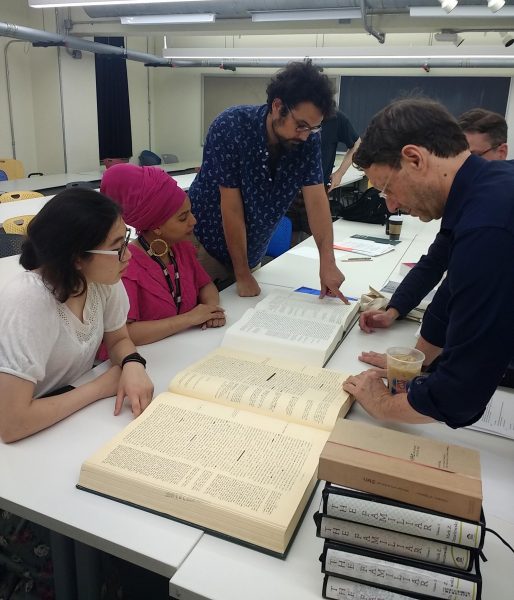
As an indication of what’s out there beyond the endless puns, I’ll sample some passages from Book I.
1. At several points, Dän partly unveils schemata about Poe. In Book I the most obvious one is the full-page diagram, p. 110, which Dän draws in the sand, putting his two friends in the middle of it so they’re inside Poe’s writing. The diagram divides Poe’s writing into five themes: “Observer & his Mood,” “Cosmology,” “Decay” (later called “rottenness, dead”), “Flora, Fauna, Population,” and “Landscape.” Within these there are themes. For the first, there’s “strange solutide,” “maze,” etc., and down near the next category, “Landscape,” there’s “sun=set colors.”
This isn’t just a random set of five categories and twenty or so subcategories: the theory is that Poe cycles through these when he writes. Sometimes clockwise, other times counter-clockwise. He gives several examples, expanding and clarifying individual readings earlier in the Book about landscape motifs and moods, and he even repeats the “Great Sand Diagram” several pages later to keep it in the reader’s mind (pp. 114, 121).
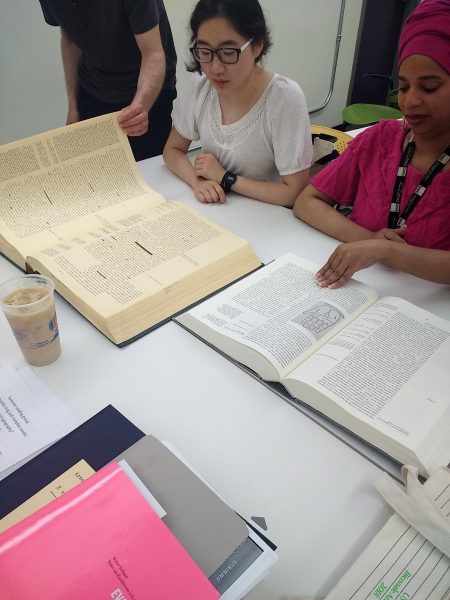
2. A schema that isn’t developed in Book 1 (I suspect it may come up later) is Dän’s insistence on the need for “the preparation of extensive tables recording ” Poe’s “backdrop=forms, & what happens infronta them – (he was after all a very heavy allegorist” (p. 123). This would involve a study of his “verbal= & pictoral seekuences,” and it could use material that had been set out earlier on theater and Poe’s theatricality.
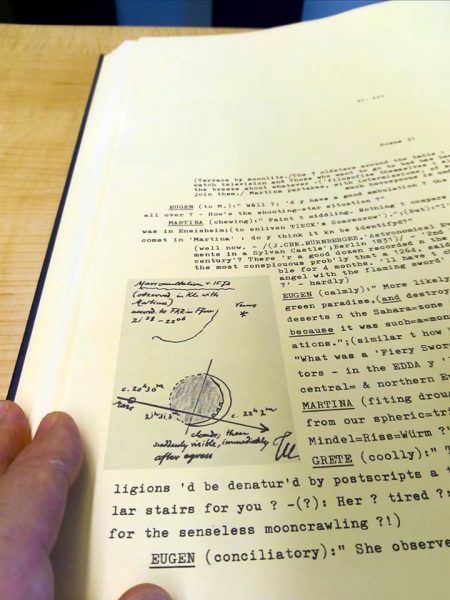
3. There are several pages in Book I that exposit Dän’s (and Schmidt’s) theories of memory and its origins in infancy. The same ideas occur in Schmidt’s essay, and they are clearly intended to be taken seriously. On p. 41 an unusually long column of single-spaced prose tells us a version of this theory with no appreciable irony or narrative distance.
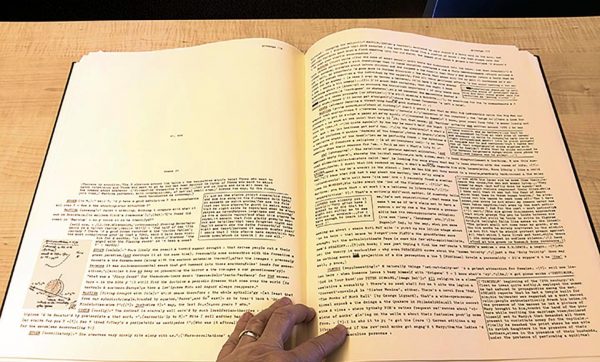
4. Schmidt, and Dän, are aware of the relation between the often pesky and trivial etyms and the larger structures of Poe’s work: and they both identify the interest of literature in the larger structures, and the interest of Poe’s in his own form of such structures. At one point Dän puts what’s at stake as a “kind of undulatory concatenation of ‘theory & oneiroid practice.” At the same time he’s aware that this alteration expresses a state of mind that may not always be active or present: “but then wouldn’t our bisecting His works be the faithful reproduction of the artist’s psychological=state ingen’rall? : That the mind’s imaginative energies periodickly gro weary?” (p. 80). The “undulation” is performed, as lierary theory likes to say, in the text, but the account here depends for its cogency on schemata like the one I’ve listed above.
5. Poe is counted as interesting and even exemplary partly because of the topography of his imagination (as in the first point, above), partly because he not a consistent example of the “fourth stage.” Paul, one of Dän’s friends, says at one point: “Needless to say, a modicum of comprehension has taken hold as to what You’re trying to suggest by stubbornly piling up these aberran details : that the gent sufferd periodick states of semi-consciousness; when he’d have to go on >anancastic< tour” (p. 89). “Anankastic,” spelled with a “k,” is an obsessive-compulsive personality disorder, which is in the DSM V. Paul goes on: “…and not just some passably normal, juvenile dromomania.” That’s an older psychiaric diagnosis whose primary symptom was wandering. This passage isn’t a key to all of Book I, but it’s a clear and typical indication that structure is at stake, and it’s the point of the endless puns.

A note on the << ; …. >> ? > ?? !!! ( [ — )) (i.e., the typography and layout)
Sometime around 2015, I wrote to Michael Orthofer, whose book (cited above) had recently appeared, to ask about Schmidt’s typographic practices. Schmidt’s theoretical essays, “Calculations I-III,” propose that his extra punctuation is a matter of simple pictures: question marks show people turning around, and so forth. From the very first pages of any Schmidt book it’s clear that’s not enough of an explanation.
When I first read Schmidt, I thought that the extra ( > ? < – – ! ! ) )’s were to be understood as signs of feeling or expression, and sometimes they are. I met John Woods around 2016 in Berlin to talk about that and other things, and he told me Schmidt said the typographic signs were indications of “sentences not important enough to write out”–meaning, in part, signs of feelings and gestures. And that’s also partly true.
I also asked Orthofer if he thought the extra punctuation marks might Schmidt’s constant, word-by-word intervention in ordinary language, and therefore, in that respect, his answer to what happens to nearly every word in Finnegans Wake.
Here’s what Orthofer wrote back, in part: “I think there isn’t one easy answer/explanation re. his punctuation mark (etc.) usage — I see it more as an evolving process of experimentation, trying out different embellishments to language, expanding ‘language’ in (also) a visual way. Certainly there are many places where they function well simply as reading-cues, too… And no doubt part of it was just affectation, too.”
The idea that the typoscripts’ anomalous and excessive punctuation is mainly one or another of these is a simplification, just as it’s too simple to say that the columns in Bottom’s Dream represent the friends’ dialogue and Poe’s texts, and the marginalia are Dan’s unspoken comments. (This is widely repeated; it’s in Langbehn and even in Woods’s translator’s afterword.) Book I certainly doesn’t observe those distinctions, and the number and alignment of columns continually shifts. I think it’s right that Schmidt’s model for the layout of Zettel’s Traum was Book I, Chapter 2 of Finnegans Wake, in which Shem and Shaun do their schoolwork. Joyce said that the left- and right-hand marginalia were Shem and Shaun, I think respectively, and the footnotes were their sister Issy. I have to look again at that chapter (and at Danis Roses’ beautiful elephant-folio-sized book James Joyce: Finnegans Wake, Book II, Chapter 2, A Facsimile of Drafts, Typescripts, & Proofs, preface by David Hayman–another expansive book, now worth $600 on the used book market) to be sure. But no matter how Schmidt understood that chapter in Finnegans Wake, Zettel’s Traum has a far more complex layout, with multiple shifting principles of organization.
There’s also the question of the aesthetics of the typewriter. Evening Edged in Gold is meticulously recreated as a typescript: it’s an uncanny match for its German original. Zettels Traum was originally another oversize typescript. It was first published in facsimile edition. Several sites show samples of that edition, including this one and this video. It was typeset by Friedrich Forssman:
It’s possible that the original typescripts had value for Schmidt and that he would have had second thoughts about Forssman’s efforts; I have been unable to find evidence of that. A German blog post makes the point using a brief passage in Zettels Traum on digitization. (Schmidt wouldn’t have thought of the digital in terms of typesetting, because he died in 1979.)
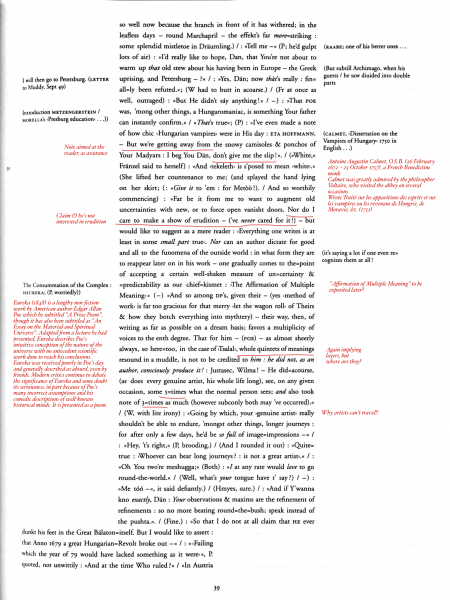
And there’s also the question of the range of references and meanings of the book’s sheer weight and bulk. The image above is from my iPad Pro, and the red annotations are mine. I read half the time on the iPad in order to relieve muscle strain. Unless you have a canted dictionary stand, Bottom’s Dream has to be read while it’s flat on a tabletop, which means you’re leaning over. Evening Edged in Gold can be propped up on a knee. I asked Woods what Schmidt said about that sort of thing, and whether he wanted his books to be put on dictionary stands or on podia like bibles in churches; he told me Schmidt “didn’t care” about the problems his enormous books pose to readers.
It isn’t easy to conclude anything firm about the physicality of Schmidt’s book, his use of typography or layout, or the meaning he assigned to the look of mechanical typewriters. All the theories about these things are sometimes true, and sometimes most of them seem to be true on any given page: and in that respect, Bottom’s Dream is as versatile a reinvention of writing as Finnegans Wake. (That’s to imply it can’t compete in terms of then number of languages or the flexibility of the puns and neologisms: but it can compete in terms of orthography and layout.)
Schmidt’s visuality
Schmidt just wasn’t very interested in pictures, despite what Dän and other characters say when they’re talking about the images in the “subconscious” (for example, p. 32, and see p. 69, where Raphael’s Sistine Madonna is studiously not seen). There is an outrageous page in Evening Edged in Gold that amounts to post-war softcore porn: exactly the sort of thing one imagines Schmidt’s characters, and even their author, reading in their bedrooms. One of the first images in that book that’s larger than a postage stamp is a leafy silhouette of someone in a hanging wicker chair. It fits very uncomfortably with the text it illustrates.
In Bottom’s Dream, Book I opens with a picture (visible in one of the illustrations, above): but you have to look very carefully to see it’s a highly schematized map of the walk the characters are taking. I could go on and on: the fact is Schmidt’s books give repeated evidence he just didn’t think much about the images he included. (In relation to that map, for example: Why is it schematized? Why is the writing so small it can barely be read, and yet it’s legible? Why are there measurements in meters? Are we or aren’t we supposed to refer to it as the characters make their way across fences and through gates? And so on.)
On the other hand it’s not simply the case that Schmidt was non-visual; he was also a photographer; his exhibitions are listed here. It’s a big subject, like everything else associated with him, and I intend to keep exploring.
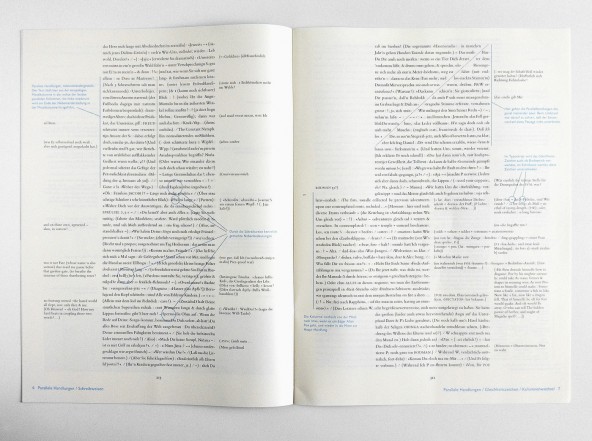
thx for this text, it’s like a revelation for me, years I’ve been trying to do something like this (typographically only) – and here, please: it was already there 🙂